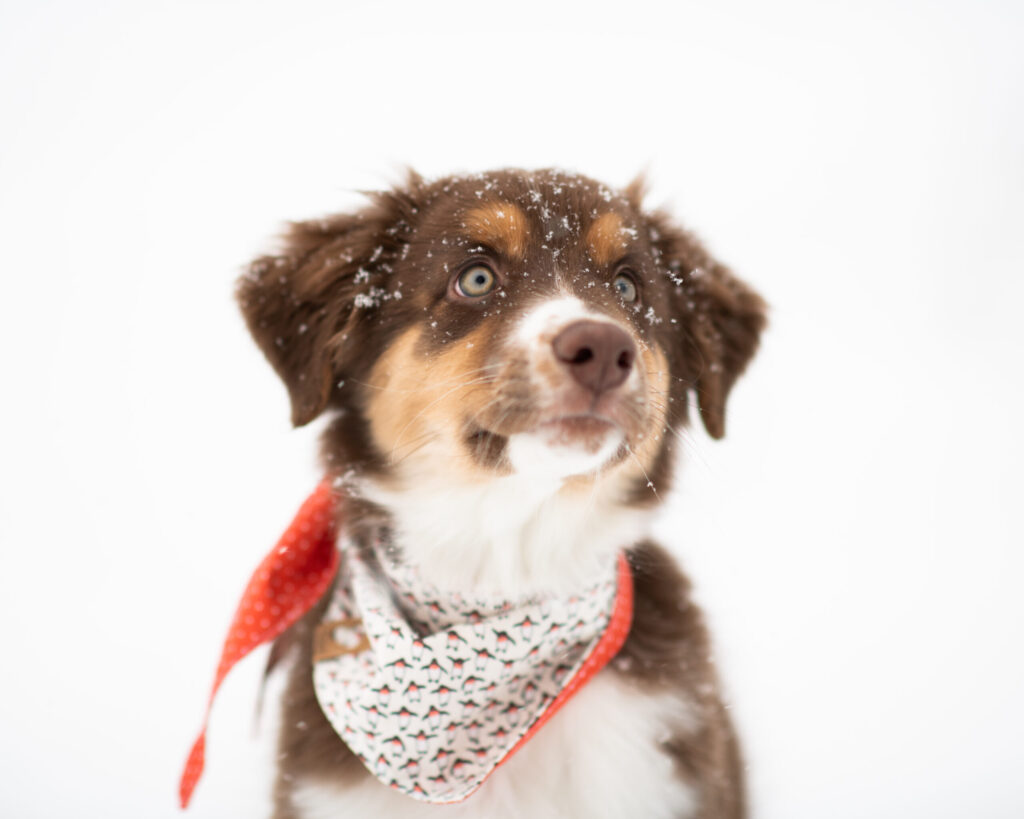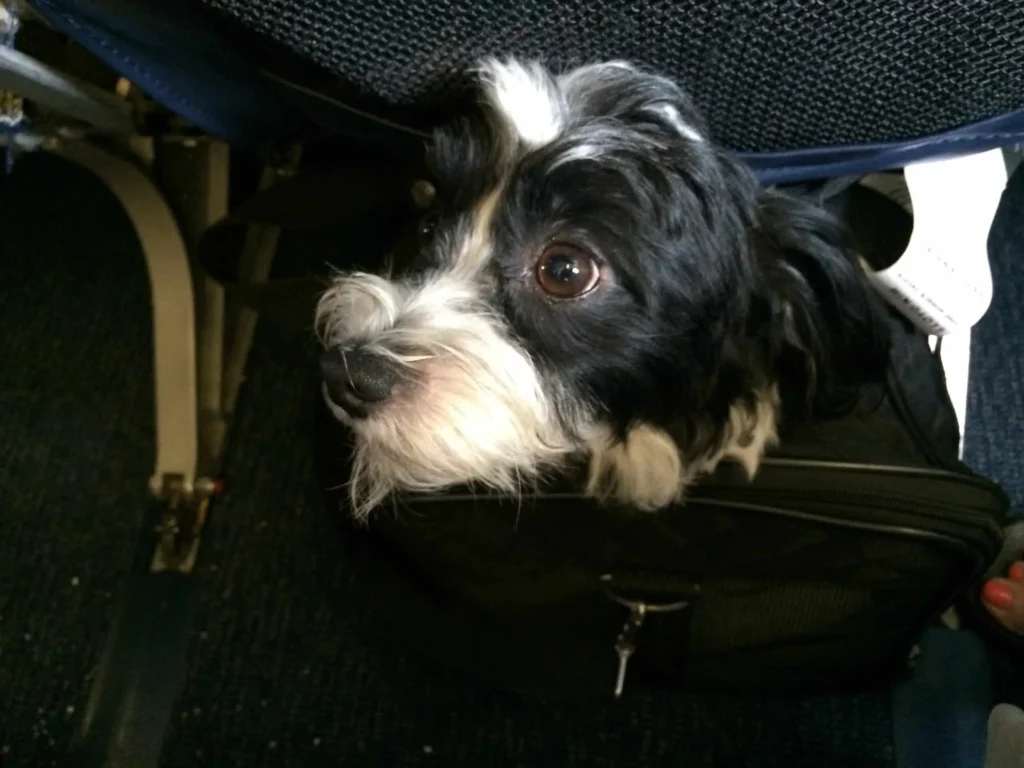
Winter can be a stressful time for those of us in the pet industry. Holidays, drab weather, shorter days. Four-legged friends help many get through the cold months, but dogs suffer during the winter, too. Even if you live in an area that sees fair weather year-round, winter brings with it a host of additional considerations and stresses for people and dogs alike. We put together this short guide on caring for dogs during the winter months so you’re not left out in the cold.
Even if it stays relatively warm during winter, the season still brings challenges when it comes to dogs. The holidays are popular travel times and that means dogs will likely be left at boarding facilities for an extended period, or they will have to undergo the stresses of travel (read about dog travel tips here). As you know, when dealing with a stressed dog, it’s important to give them a way to stimulate themselves in non-destructive ways. Chew toys, squeaky toys, or reward-based toys like KONG toys can help dogs get their minds off separation anxiety, of course, but if the toy is one of their favorites from back home, that’s even better!
By now, you’re probably a pro at reading dog body language and context cues to find out what’s going on in their heads. During such busy times, though, it’s easy to get in over your head and overlook dog behaviors. If a dog is stressed or sad, it may be best to keep them separate from the other dogs in case they respond to those feelings with agitation or outbursts—but if the dog plays well with other dogs, some pup socializing time could do wonders for a nervous dog. You know the drill, it’s just doubly important to stay vigilant during the holiday season.
While we’re on the subject of behavior, everyone knows that dogs sniff everything. They form a picture of the world using their noses. Dogs particularly love to smell along the grass or dirt outside. Yards provide an abundance of stimulating scents to occupy dogs’ noses and attention. If your yard is covered in gravel, cement, or other surfaces that place an impermeable barrier between the ground and dog noses, it could make dogs stressed and restless. It can be difficult to maintain a grass yard, especially during the winter. If you want the benefits of artificial turf for dogs along with the smells and feel of a regular grass yard, Natura hybrid turf protects your ground and prevents mud puddles, but still allows dogs to be dogs.
The most important element of dog care for the winter is to keep pets safe in the cold weather. The common refrain you’ll hear regarding temperature and pet safety is, ‘If you’re cold, they’re cold.’ This is a well-intentioned guideline, but it falls short in practice. Consider the range of body sizes, shapes, and coat types that different breeds of dogs have. A husky is in heaven when it can roll around in the snow, whereas a chihuahua often needs some type of (adorable) garment and highly limited time outdoors in sub-freezing temperatures.
Understanding a dog’s tolerance for cold or warm temperatures isn’t as simple as determining coat thickness. Take our intern, Bear, for example; Bear is a Havanese and at first his coat may appear relatively thick and warm—when he’s not chasing his youth with a puppy cut—but because Havanese are suited to warm climates, their fur is actually very fine and light to serve as a sunshade and keep them cool in the hot Cuban sun.

If a dog is a recognizable breed, or the owner has had genetic tests done to discover their dog’s breed, it’s simple to check how well they might tolerate colder temperatures. You can use this handy webpage to help you find out if a dog breed is known to tolerate cold temperatures well. On the other side of things, you can find out if a breed is poorly suited for cold weather. If a dog is poorly suited for cold weather, or if they are going to spend an extended time outside, it’s important that the owners provide a dog jacket to keep them warm. (Hot take: they should be called dog vests.)
Even if a breed is well-suited to the cold, low temperatures can exacerbate certain medical conditions like arthritis. Just like humans, dog joints become stiffer in cold weather. Talk to the owners about their dog’s health conditions to determine if the cold weather is somehow detrimental or uncomfortable for them as a result of their conditions. While a husky may be able to tolerate shockingly cold temperatures, their joints may ache and stiffen, causing them discomfort.
Outdoor shelters are important for even the hardiest dogs if you plan on keeping them outside in the cold. The kind of shelter you install in your facility depends on your space and budget. Shelters can range from plastic igloo-shaped molded structures to elaborate wooden shed-like structures that mimic the comforts of human homes. Obviously, your particular business needs will determine what kind of shelter you invest in. The most important thing to consider when it comes to wintertime shelter at your facility is heat loss through the ground. While a shelter may provide relief from wind, many are designed without a floor beneath. In the cold weather, heat is quickly sapped from a dog’s body through the ground. Placing a bed or hay on the ground where the dog lies helps to insulate them from the cold.
During the winter, pups’ paws take quite a bit of abuse. Imagine walking around on a cold winter day in just your bare feet. Brrr! But it’s not just cold paws you have to worry about. During the winter, streets and sidewalks are treated with salt and, in some cases, antifreeze chemicals. You don’t want clients and employees to slip and injure themselves in the winter, but salt isn’t as harmless as it seems. Just like with humans, salt dries out skin, causing dogs’ paws to crack, possibly leading to wounds and subsequent infection. What’s worse, dogs will often lick their paws after they come inside, and if poisonous antifreeze or other chemicals are on their paws then they will directly consume them this way.
While many dog owners use booties to keep their dog’s paws safe, clean, and dry, that solution usually isn’t feasible when scaled up to the number of dogs in your facility. Limiting outside time and cleaning their paws when they come inside will reduce the wear and tear on the dogs’ paws and keep your facility cleaner, thereby reducing overall labor costs.
If you want to keep paws cleaner year-round, we offer a hybrid turf solution that lets you keep your yard while enjoying the benefits of artificial dog turf. Natura dog turf places a barrier between paws and the ground so cold or frozen puddles, dirt, and chemicals are less likely to come in contact with paws and shoes, and are therefore less likely to enter your facility.
Though it can be particularly difficult to remain stress-free during the holidays, your stress and hectic schedule might adversely affect dogs that are staying at your facility. We all know dogs have remarkable emotional intelligence. They read human emotions well and adapt accordingly. It’s not just dogs who get stressed during the holidays. Though the daycare and pet boarding industry may get hectic over the winter, be sure to take some time for yourself. Go out and see a movie, have a nice meal, do anything that lets you disconnect from your pet business for a little while. You deserve it. If your area receives a lack of sunlight during the winter, and that tends to bother you, it might be worth the investment to buy a UV lamp designed to alleviate the symptoms of Seasonal Affective Disorder (SAD). Exercise is also a great way to keep the winter blues away. What you do enables others to enjoy their holiday season with loved ones. We at Natura want to extend a big thank you for what you do. It matters.
Subscribe
to our newsletter
Recent Posts
Contact us:
2381 Centerline Industrial Drive
St. Louis, MO 63146
Quick Links
© 2025 GrassWorx, LLC. All Rights Reserved. Natura® is a registered trademark of GrassWorx, LLC. St. Louis, MO 63146.